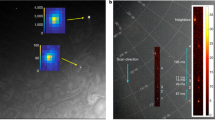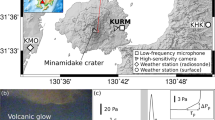Abstract
From August to October, 1976, La Soufrière de Guadeloupe was observed, and recorded with an automated sequence camera and numerous handheld cameras. During the period of observation, the nature of volcanic activity ranged from mild steam emission to moderately energetic phreatic eruptions.
Background fumarolic activity (steam emission) was characterized by the emission of generally tephra-free steam clouds 50 to 150 m above the summit. The clouds rose buoyantly above the vent and were blown downwind at prevailing wind velocities. Phreatic eruptions were well-documented on September 22, October 2, and October 4. In the latter two eruptions, small bursts of tephra-laden steam erupted at intervals of 30 to 45 min, and rose from 350 to 500 m above the summit. In the largest observed eruption, that of October 2, the steam and tephra cloud rose to a maximum height of 600 to 650 m in 20 min. A white vapor cloud and a medium gray, tephra-laden cloud were erupted simultaneously from the summit vent and both were surrounded by a vapor collar: the clouds were thoroughly mixed within 1 km downwind of the summit. The concurrent growth of clouds from separate vents (summit and flank) implies a common source. Simultaneous eruption of tephra-free and tephra-laden clouds from the same vent is puzzling and implies: (i) lateral changes in the degree of alteration of dome rocks along the elongate vent, hence erodability of the dome lavas, or (ii) differences in the gas velocities. These «mixed» clouds moved westward, downwind and downslope as a density current, along the watersheds of the R. Noire and R. des Pères with an approximate velocity of 10 to 25 m/sec. Upon reaching the sea the clouds continued to move forward, but at a decreased velocity, and spread laterally, having left behind the restrictions of valley walls. A thin gray veneer of moist tephra, ranging from several cm thick near the dome to less than 1 mm thick several km downwind, was deposited along a narrow corridor southwest of the summit. Tephra from the phreatic eruptions consisted mostly of hydrothermally altered lithic, mineral, and glass fragments derived from dome lavas; no fresh (juvenile) pyroclasts were present in the tephra.
Absence of juvenile tephra at La Soufrière supports the view that activity was due to groundwater circulating in a vapor-dominated geothermal system, probably driven by a shallow heat source. At La Soufrière, most vapor-dominated systems are located in elevated areas of groundwater recharge where groundwater movement is downward and outward. The sporadic phreatic eruptions may be related to the rate of recharge of meteoric waters within the dome, the decrease in pore pressure during fortnightly tidal minimums or both. Whatever the triggering mechanism, vapor-dominated fluids eroded vent walls during phreatic eruptions and carried out fine-grained, hydrothermally altered, pre-existing dome material as tephra.
Similar content being viewed by others
References
Barrabé, L. andJolivet, J., 1958,Les recentes manifestations d’activité de la Guadeloupe (Petites Antilles). Bull. Volcanol.,19, p. 143–157.
Briggs, G.A., 1969,Plume Rise, U.S. Atomic Energy Comm. Critical Review Ser. USAEC Report TID-25075, 81 pp.
Bruet, E. 1953,L’âge Absolu de la dernière grande éruption pèlèenne de la Soufrière de la Guadeloupe. Bull. Volcanol.,13, p. 105–107.
Folk, R. L., 1968,Petrology of Sedimentary Rocks, Hemphill’s, Austin, Texas, 170 pp.
Healy, J., 1976,Geothermal Fields in Zones of Recent Volcanism. Proc. U.N. Second Conf. on Geothermal Energy, pp. 415–422.
Lasserre, G. 1961,La Guadeloupe. Un. Fr. d’Impression, Paris, 1135 pp.
Mauk, F.J. andJohnson, M. 1973,On the Triggering of Volcanic Eruptions by Earth Tides. Jour. Geophys. Res.,78, p. 3356–3362.
Rinehart, J.S. 1976,Alteration of Flow Characteristics within Geothermal Areas by Tidal Forces. Proc. U.N. Second Conf. on Geothermal Energy, pp. 549–551.
Robson, G.R. andTomblin, J.F. 1966,Catalogue of the Active Volcanoes and Solfatara Fields of the West Indies. Cat. of the Active Volcanoes of the World, part. XX. Intern. Assoc. Volc., Roma 56 pp.
Roobol, M.J. andSmith, A.L., 1976,Mount Pelée, Martinique: A pattern of Alternating Eruptive Styles, Geology,4, p. 521–524.
Settle, M., 1976,Rise of Volcanic Eruption Clouds: relationship between Cloud Height and Eruption Intensity. U.S. Air Force Geophys. Lab. Environ. Res. Papers, no. 566 (AFGL-TR-76-0127), 37 pp.
Sparks, R.S.J. 1976,Grain Size Variation in Ignimbrites and Implications for the Transport of Pyroclastic Flows. Sedimentology,23, p. 147–188.
Author information
Authors and Affiliations
Rights and permissions
About this article
Cite this article
Heiken, G., Crowe, B., McGetchin, T. et al. Phreatic eruption clouds: the activity of la Soufrière de Guadeloupe, F.W.I., August — October, 1976. Bull Volcanol 43, 383–395 (1980). https://doi.org/10.1007/BF02598039
Issue Date:
DOI: https://doi.org/10.1007/BF02598039




